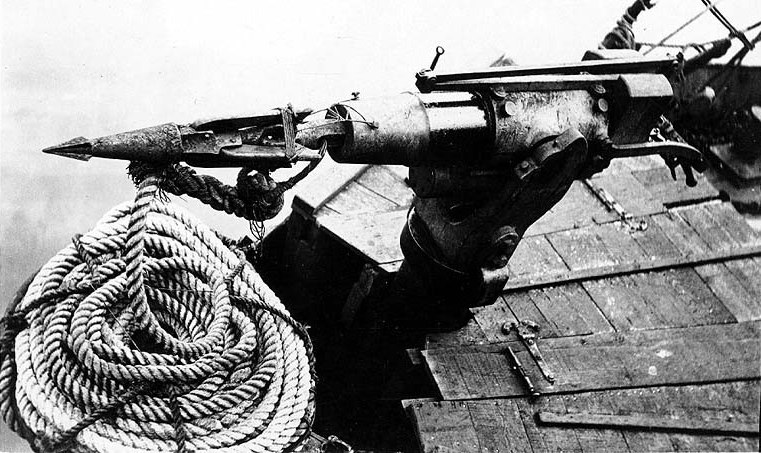
A
deck mounted cannon on a whaling ship in Alaska in 1915 with an
explosive head.
A harpoon is a long spear-like instrument used in fishing, whaling, sealing, and other marine hunting to catch large fish or marine mammals such as whales. It accomplishes this task by impaling the target animal and securing it with barb or toggling claws, allowing the fishermen to use a rope or chain attached to the projectile to catch the animal. A harpoon can also be used as a weapon.
The two flue harpoon was the primary weapon used in whaling around the world, but it tended to penetrate no deeper than the soft outer layer of blubber. Thus it was often possible for the whale to escape by struggling or swimming away forcefully enough to pull the shallowly embedded barbs out backwards. This flaw was corrected in the early nineteenth century with the creation of the one flue harpoon; by removing one of the flues, the head of the harpoon was narrowed, making it easier for it to penetrate deep enough to hold fast. In the Arctic, the indigenous people used the more advanced toggling harpoon design. In the mid-19th century, the toggling harpoon was adapted by Lewis Temple, using iron. The Temple toggle was widely used, and quickly came to dominate whaling.
In the novel Moby-Dick, Herman Melville explained the reason for the harpoon's effectiveness:
In most land animals there are certain valves or flood gates in many of their veins, whereby when wounded, the blood is in some degree at least instantly shut off in certain directions. Not so with the whale; one of whose peculiarities is, to have an entire non-valvular structure of the blood-vessels, so that when pierced even by so small a point as a harpoon, a deadly drain is at once begun upon his whole arterial system; and when this is heightened by the extraordinary pressure of
water at a great distance below the surface, his life may be said to pour from him in incessant streams. Yet so vast is the quantity of blood in him, and so distant and numerous its interior fountains, that he will keep thus bleeding and bleeding for a considerable period; even as in a drought a
river will flow, whose source is in the well springs of far off and undiscernible hills.
— Herman Melville, Moby-Dick, 1851
He also describes another device that was at times a necessary addition to harpoons:
All whale-boats carry certain curious contrivances, originally invented by the Nantucket Indians, called druggs [i.e. drogues]. Two thick squares of
wood of equal size are stoutly clenched together, so that they cross each other's grain at right angles; a line of considerable length is then attached to the middle of this block, and the other end of the line being looped, it can in a moment be fastened to a harpoon. It is chiefly among gallied [frightened] whales that this drugg is used. For then, more whales are close round you than you can possibly chase at one time. But sperm whales are not every day encountered; while you may, then, you must kill all you can. And if you cannot kill them all at once, you must wing [injure] them, so that they can be afterwards killed at your leisure. Hence it is that at times like these the drugg comes into requisition.
— Herman
Melville, Moby-Dick 1851
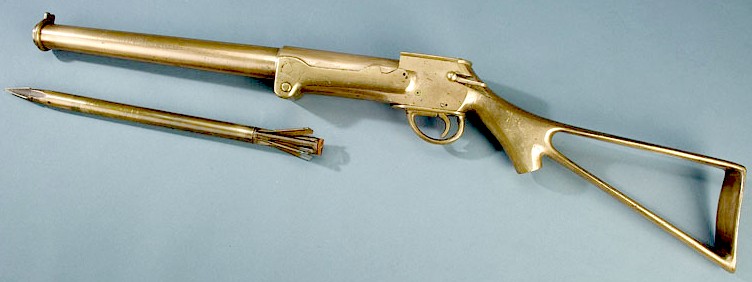
New Bedford, Massachusetts
- Explosive lances were designed to kill a whale by exploding inside its body. Many different types were invented in the late 19th century. When they worked properly, they were extremely efficient.
They could either be shot out of guns or set at the end of darting guns. These devices resembled harpoon handles, to which the explosive lances were fixed. Once a plunger touching the whale’s skin moved a specific length, it triggered an explosive charge that shot the lance into the whale’s body.
This weapon was manufactured by Frank E. Brown
MODERN EXPLOSIVE WHALING HARPOON GUN
In 1870, the Norwegian shipping magnate Svend Foyn patented and pioneered the modern exploding whaling harpoon and gun. Foyn had studied the American method in Iceland. His basic design is still in use today. He perceived the failings of other methods and solved these problems in his own system. He included, with the help of H.M.T. Esmark, a grenade tip that exploded inside the whale. This harpoon design also utilized a shaft that was connected to the head with a moveable joint. His original cannons were muzzle-loaded with special padding and also used a unique form of gunpowder. The cannons were later replaced with safer breech-loading types.
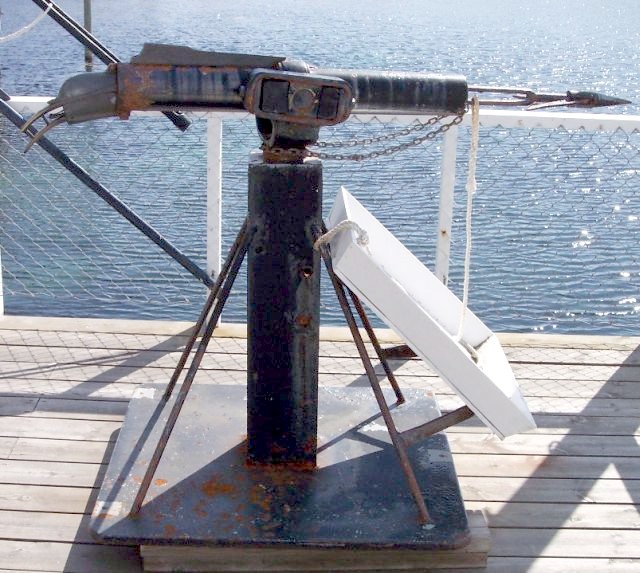
Together with the steam-powered whale catcher, this development ushered in the modern age of commercial whaling. Euro-American whalers were now equipped to hunt faster and more powerful species, such as the rorquals. Because rorquals sank when they died, later versions of the exploding harpoon injected air into the carcass to keep it afloat.
The modern whaling harpoon consists of a deck-mounted launcher (mostly a cannon) and a projectile which is a large harpoon with an explosive (penthrite) charge, attached to a thick rope. The spearhead is shaped in a manner which allows it to penetrate the thick layers of whale blubber and stick in the flesh. It has sharp spikes to prevent the harpoon from sliding out. Thus, by pulling the rope with a motor, the whalers can drag the whale back to their ship.
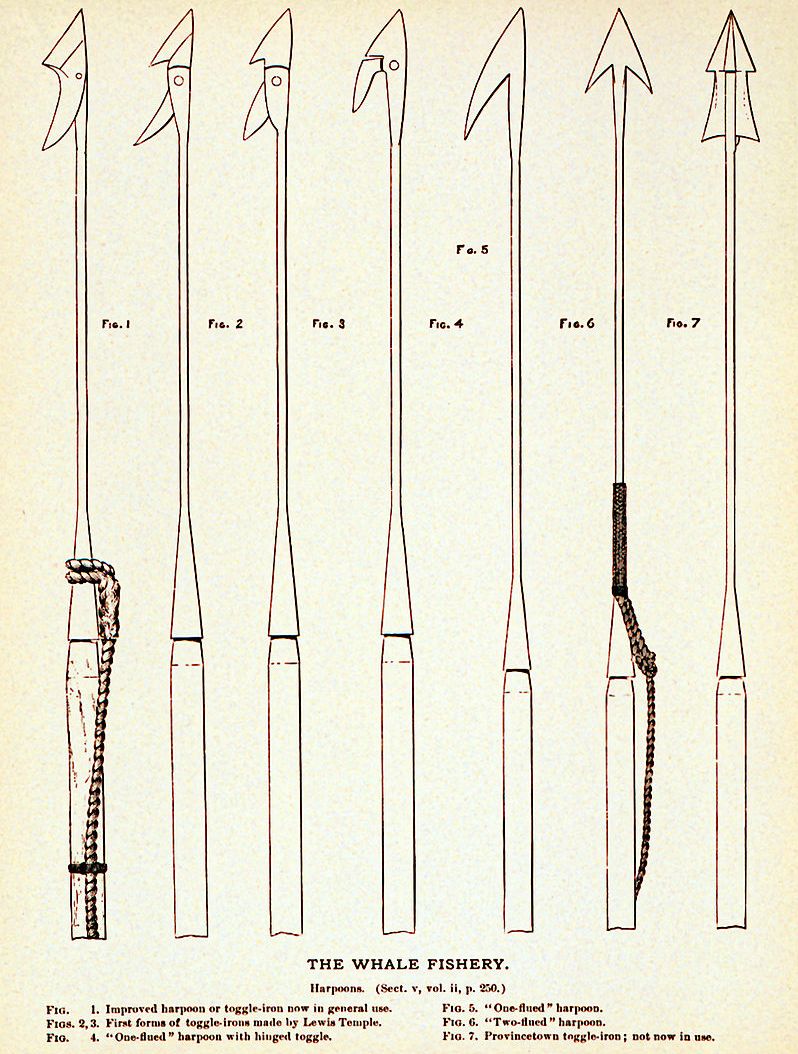
Harpoon
types and development for whale fishing, all reliant on the operators
skill.
HISTORY
The first use of explosives in the hunting of whales was made by the British South Sea Company in 1737, after some years of declining catches. A large fleet was sent, armed with cannon-fired harpoons. Although the weaponry was successful in killing the whales, most of the catch sank before being retrieved. However, the system was still occasionally used, and underwent successive improvements at the hands of various inventors over the next century, including Abraham Stagholt in the 1770s and George Manby in the early 19th century.
William Congreve, who invented some of the first rockets for British Army use, designed a rocket-propelled whaling harpoon in the 1820s. The shell was designed to explode on contact and impale the whale with the harpoon. The weapon was in turn attached by a line to the boat, and the hope was that the explosion would generate enough gas within the whale to keep it afloat for retrieval. Expeditions were sent out to try this new technology; many whales were killed, but most of them sank. These early devices, called bomb lances, became widely used for the hunting of humpbacks and right whales. A notable user of these early explosive harpoons was the American Thomas Welcome Roys in 1865, who set up a shore station in Seydisfjördur, Iceland. A slump in oil prices after the American Civil War forced their endeavor into bankruptcy in 1867.
An early version of the explosive harpoon was designed by Jacob Nicolai Walsøe, a Norwegian painter and inventor. His 1851 application was rejected by the interior ministry on the grounds that he had received public funding for his experiments. In 1867, a Danish fireworks manufacturer, Gaetano Amici, patented a cannon-fired harpoon, and in the same year, an Englishman, George Welch, patented a grenade harpoon very similar to the version which transformed whaling in the following decade.
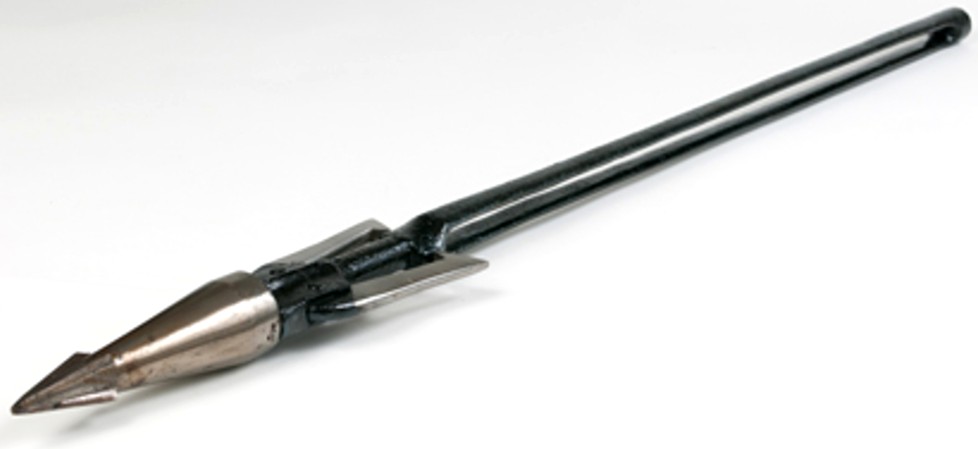
An
explosive head harpoon at the Dundee Heritage Trust
SHIPS
NAMED HARPOONER:
- Harpooner (1769 ship) was launched at Whitby in 1769, or possibly a few years later. Her early career is obscure. She may have been a Greenland whaler between 1786 and 1792. She appeared in Lloyd's Register in 1801, and thereafter traded across the Atlantic. She was wrecked in 1816 with heavy loss of life.
- Harpooner (1771 ship) was launched at Liverpool. In 1778 she became a privateer. She captured at least two French merchantmen before a French privateer captured her in January 1780.
- Harpooner was launched at Havana, c.1761. From 1781 to 1785 she was a Salisbury (1781 ship). In 1785 she became the Northern Whale
Fishery whaler Rebecca. She became Harpooner in 1787. She was lost in 1789.
- Harpooner (1791 ship) was launched at Bristol. A French privateer captured her in 1793 on Harpooner's first whaling voyage to the South Seas and took her into Boston. This gave rise to an important court case.
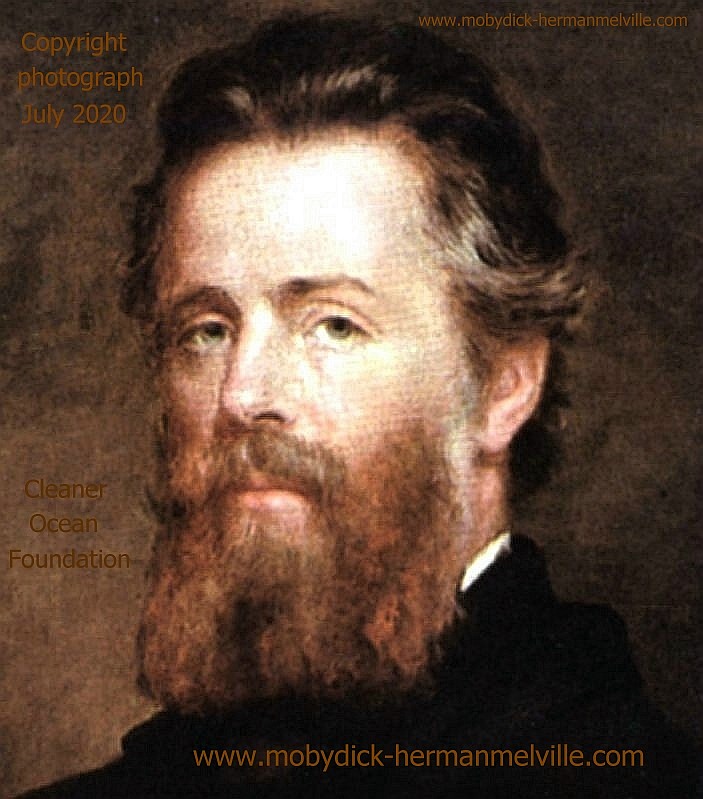
Herman
Melville was the author of a novel about a way of life that we'd now consider an illegal activity,
the commercial hunting of whales for oil and meat, using harpoons.
Please use our
A-Z INDEX to
navigate this site





